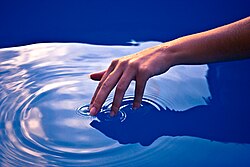Mechanical wave
This article needs additional citations for verification. (April 2013) |

A mechanical wave is a wave that propagates as an oscillation of matter, and therefore transfers energy through a medium.[1] While waves can move over long distances, the movement of the medium of transmission—the material—is limited. Therefore, oscillating material does not move far from its initial equilibrium position. Mechanical waves transport energy only. This energy propagates in the same direction as the wave. Any kind of wave (mechanical or electromagnetic) has a certain energy. No material is transported as a result of mechanical waves. Mechanical wave can be produced only in media which possess elasticity and inertia.
A mechanical wave requires an initial energy input. Once this initial energy is added, the wave travels through the medium until all its energy is transferred. In contrast, electromagnetic waves require no medium, but can still travel through one.
One important property of mechanical waves is that their amplitudes possess an unusual form, displacement divided by reduced wavelength. When this gets comparable to unity, significant nonlinear effects such as harmonic generation may occur, and, if large enough, may result in chaotic effects. For example, waves on the surface of a body of water break when this dimensionless amplitude exceeds 1, resulting in a foam on the surface and turbulent mixing. Some of the most common examples of mechanical waves can be water waves, sound waves, etc.
There are three types of mechanical waves: transverse waves, longitudinal waves, and surface waves.
Wave Types
Transverse wave
Transverse waves cause the medium to vibrate at a right angle to the direction of the wave or energy being carried by the medium. Transverse waves have two parts—the crest and the trough. The crest is the highest point of the wave and the trough is the lowest. Distance between a crest and a trough is half of wavelength. The wavelength is the distance from crest to crest or from trough to trough. Light has properties of a transverse wave, although it is an electromagnetic wave.
Longitudinal wave
Longitudinal waves cause the medium to vibrate parallel to the direction of the wave. The speed of the longitudinal wave is increased in higher index of refraction, due to the closer proximity of the atoms in the medium that is being compressed. Sound is considered a longitudinal wave.
Surface waves
This Type of wave travels along a surface that is between two media. An example of a surface wave would be waves in a pool, or in an ocean, lake, or any other type of water body. There are two types of surface waves, namely Rayleigh waves and Love waves.
Rayleigh waves, also known as ground roll, are waves that travel as ripples with motion similar to those of waves on the surface of water. Rayleigh waves are much slower than body waves, roughly 90% of the velocity of surface waves for a typical homogeneous elastic medium.
A Love wave is a surface waves having horizontal waves that are shear or transverse to the direction of propagation. They usually travel slightly faster than Rayleigh waves, about 90% of the surface wave velocity, and have the largest amplitude.▐╘µ↨ed▼Ü{☺☺☺☺{{6µ£₧ôƒ
Examples
Sound Waves
References
- ^ Giancoli, D. C. (2009) Physics for scientists & engineers with modern physics (4th ed.). Upper Saddle River, N.J.: Pearson Prentice Hall.
